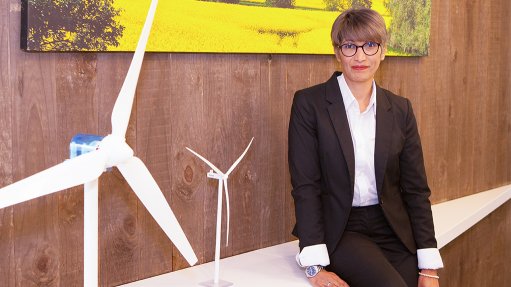
Enertrag South Africa project development head Mercia Grimbeek
Co-locating wind and solar photovoltaic (PV) facilities at a single grid connection point could help maximise the use of South Africa’s existing, albeit constrained, transmission network capacity and would improve supply consistency, Enertrag South Africa project development head Mercia Grimbeek argues.
Grimbeek notes that, while solar and wind power plants can be built in a fraction of the time needed to build other thermal power solutions, more connecting points on the grid are required to alleviate pressure, especially in the Northern, Eastern and Western Cape provinces.
This reality came into sharp focus during South Africa’s most recent public procurement round, when none of the 23 wind projects that participated in the bid window advanced to preferred-bidder status, after Eskom indicated that the network capacity required for the projects had been absorbed.
It is likely that the next bid window will identify specific areas where there is capacity to build new renewables projects, including in Mpumalanga, where transmission infrastructure located at coal power stations scheduled for retirement could be repurposed.
However, Grimbeek believes South Africa should also explore building wind and solar PV and possibly hydro plants alongside each other so that a single transmission connection point can be used more effectively.
“By co-locating a wind and solar facility, the network operator could in effect have a more consistent uptake of electrons at a particular connection point on the grid.
“For example, if one were to construct a 200 MW wind farm adjacent to a 200 MW solar farm, this does not mean 400 MW injected into the grid all the time.
“Instead, the wind production is likely to happen in the late afternoon, throughout the night and in the morning, whereas the solar production happens during the day and hence the combined energy production happens more consistently at a single connection point,” she explains.
Although co-location has not yet been proposed in South Africa, Enertrag’s German parent is currently constructing a solar facility adjacent to an existing wind facility in the north of Germany, where it has experience in system optimisation and grid management.
“Operating the various technologies as a comprehensive energy system has taught us that consistent energy supply from renewable sources is possible and that grid frequencies and volatility can be managed effectively,” Grimbeek says, adding that the inclusion of battery storage further increases the consistency of supply.
“Independent power producers are likely to find this a viable business model, as studies indicate a small overlap.
“As a developer, we would consider an overlap of between 3% and 7% reasonable, provided that there is a mechanism to recoup the cost of the overlap from the grid operator,” Grimbeek adds.